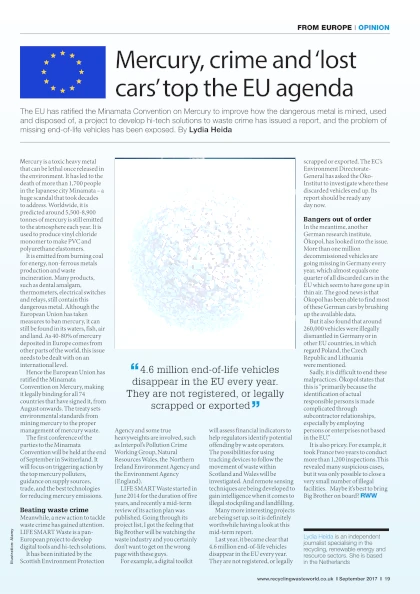Mercury, crime and lost cars top the EU agenda
The EU has ratified the Minamata Convention on Mercury to improve how the dangerous metal is mined, used and disposed of, a project to develop hi-tech solutions to waste crime has issued a report, and the problem of missing end-of-life vehicles has been exposed.
Mercury is a toxic heavy metal that can be lethal once released in the environment. It has led to the death of more than 1,700 people in the Japanese city Minamata – a huge scandal that took decades to address.
Worldwide, around 5,500-8,900 tonnes of mercury is still emitted to the atmosphere each year.
It is used to produce vinyl chloride monomer, to make PVC and polyurethane elastomers.
Mercury is emitted from burning coal for energy, non-ferrous metals production and waste incineration. Many products, such as dental amalgam, thermometers, electrical switches and relays, still contain this dangerous metal.

Mining mercury
Although the European Union has taken measures to ban mercury, it can still be found in its waters, fish, air and land. As 40-80% of mercury deposited in Europe comes from other parts of the world, this issue needs to be dealt with on an international level.
Hence the European Union has ratified the Minamata Convention on Mercury, making it legally binding for all 74 countries that have signed it, from August onwards. The treaty sets environmental standards from mining mercury to the proper management of mercury waste.
The first conference of the parties to the Minamata Convention will be held at the end of September in Switzerland. It will focus on triggering action by the top mercury polluters, guidance on supply sources, trade, and the best technologies for reducing mercury emissions.
Waste crime
Meanwhile, a new action to tackle waste crime has gained attention. LIFE SMART Waste is a pan-European project to develop digital tools and hi-tech solutions. It has been initiated by the Scottish Environment Protection Agency and some true heavyweights are involved, such as Interpol’s Pollution Crime Working Group, Natural Resources Wales, the Northern Ireland Environment Agency and the Environment Agency (England).
LIFE SMART Waste started in June 2014 for the duration of five years, and recently a mid-term review of its action plan was published. Going through its project list, I got the feeling that Big Brother will be watching the waste industry and you certainly don’t want to get on the wrong page with these guys.
For example, a digital toolkit will assess financial indicators to help regulators identify potential offending by waste operators. The possibilities for using tracking devices to follow the movement of waste within Scotland and Wales will be investigated.
Missing millions
And remote sensing techniques are being developed to gain intelligence when it comes to illegal stockpiling and landfilling. Many more interesting projects are being set up, so it is definitely worthwhile having a look at this mid-term report.
Last year, it became clear that 4.6 million end-of-life vehicles disappear in the EU every year. They are not registered, or legally scrapped or exported. The EC’s Environment Directorate-General has asked the Öko-Institut to investigate where these discarded vehicles end up. Its report should be ready any day now.
In the mean time, another German research institute, Ökopol, has looked into the issue.
More than one million decommissioned vehicles are going missing in Germany every year, which almost equals one quarter of all unregistered discarded cars in the EU. The good news is that Ökopol has been able to find most of these German cars by brushing up the available data. (...)
Publication: Recycling & Waste World
Date: September 2017
Would you like to read the entire article? If so, please let me know!
CONTACT MEOut of the skies | Recycling of old aircraft
Read More

Worrying numbers put CEP into perspective

A resource revolution? Don’t hold your breath
Interested in working together?
I'd love to hear from you.